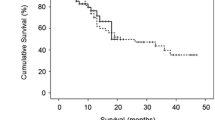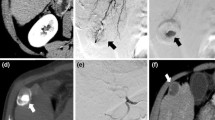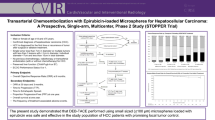Abstract
The purpose of this study was to investigate the clinical outcomes of bland embolization using superabsorbent polymer microspheres (SAP-TAE) as an initial therapeutic option for previously untreated hepatocellular carcinoma (HCC) ineligible for resection or ablation. Fifty-nine patients with previously untreated HCC unamenable to surgery or ablation underwent bland embolization using 100- to 200-μm reconstituted SAP particles (SAP-TAE) as the initial treatment. SAP-TAE was repeated as needed based on tumor response but was switched to chemoembolization when necessary to control residual or progressive tumor. Early tumor response was assessed by contrast-enhanced CT according to RECIST and EASL criteria 1 month after the initial SAP-TAE. The overall survival was calculated using the Kaplan–Meier method. The overall mean follow-up period was 30.6 months (range, 7–59 months). A total of 121 sessions of SAP-TAE were performed, with 1–5 sessions per patient (mean, 2.1 sessions). The mean period of repeated SAP-TAE was 15.6 months (range, 1–51 months), and it exceeded 1 and 2 years in 32 (54%) and 15 (25%) patients, respectively. Thirteen (22%) patients underwent repeated SAP-TAE alone, and the remaining 46 (78%) patients underwent subsequent chemoembolization. No major complication was observed and postembolization syndrome was minimal after SAP-TAE in all patients. Response rate was 14% and 66% by RECIST and EASL criteria, respectively. Overall survival rates were 100% and 83% at 1 and 2 years, respectively, and median survival time was 30 months. In conclusion, SAP-TAE was a safe and repeatable option as the induction therapy for HCC unamenable to surgery or ablation, despite the high incidence of converting to TACE during the total course.




Similar content being viewed by others
References
Parkin DM, Bray F, Ferlay J, Pisani P (2001) Estimating the world cancer burden: Globocan 2000. Int J Cancer 94:153–156
Llovet JM, Real MI, Montana X et al (2002) Arterial embolisation or chemoembolisation versus symptomatic treatment in patients with unresectable hepatocellular carcinoma: a randomised controlled trial. Lancet 359:1734–1739
Llovet JM, Bruix J (2003) Systematic review of randomized trials for unresectable hepatocellular carcinoma: chemoembolization improves survival. Hepatology 37:429–442
Osuga K, Khankan AA, Hori S et al (2002) Transarterial embolization for large hepatocellular carcinoma with use of superabsorbent polymer microspheres: initial experience. J Vasc Interv Radiol 13:929–934
Murakami T, Kim T, Takamura M et al (2001) Hypervascular hepatocellular carcinoma: detection with double arterial phase multi-detector row helical CT. Radiology 218:763–767
Murakami T, Oi H, Hori M et al (1997) Helical CT during arterial portography and hepatic arteriography for detecting hypervascular hepatocellular carcinoma. AJR 169:131–135
Jiaqi Y, Hori S, Minamitani K et al (1996) A new embolic material: super absorbent polymer (SAP) microsphere and its embolic effects. Nippon Igaku Hoshasen Gakkai Zasshi 56:19–24
Therasse P, Arbuck SG, Eisenhauer EA et al (2000) New guidelines to evaluate the response to treatment in solid tumors. European Organization for Research and Treatment of Cancer, National Cancer Institute of the United States, National Cancer Institute of Canada. J Natl Cancer Inst 92:205–216
Bruix J, Sherman M, Llovet JM et al (2001) Clinical management of hepatocellular carcinoma. Conclusions of the Barcelona-2000 EASL conference. European Association for the Study of the Liver. J Hepatol 35:421–430
Brown DB, Cardella JF, Sacks D et al (2006) Quality improvement guidelines for transhepatic arterial chemoembolization, embolization, and chemotherapeutic infusion for hepatic malignancy. J Vasc Interv Radiol 17:225–232
Trotti A, Colevas D, Setser A et al (2003) CTCAE v 3.0: development of a comprehensive grading system for the adverse effects of cancer treatment. Semin Radiat Oncol 13:176–181
Stampfl S, Stampfl U, Rehnitz C et al (2007) Experimental evaluation of early and long-term effects of microparticle embolization in two different mini-pig models. Part I: kidney. CardioVasc Interv Radiol 30:257–267
Brown KT, Nevins AB, Getrajdman GI et al (1998) Particle embolization for hepatocellular carcinoma. J Vasc Interv Radiol 9:822–828
Maluccio M, Covey AM, Gandhi R et al (2005) Comparison of survival rates after bland arterial embolization and ablation versus surgical resection for treating solitary hepatocellular carcinoma up to 7 cm. J Vasc Interv Radiol 16:955–961
Rand T, Loewe C, Schoder M et al (2005) Arterial embolization of unresectable hepatocellular carcinoma with use of microspheres, lipiodol, and cyanoacrylate. CardioVasc Interv Radiol 28:313–318
Covey AM, Maluccio MA, Schubert J et al (2006) Particle embolization of recurrent hepatocellular carcinoma after hepatectomy. Cancer 106:2181–2189
Brown KT, Koh BY, Brody LA et al (1999) Particle embolization of hepatic neuroendocrine metastases for control of pain and hormonal symptoms. J Vasc Interv Radiol 10:397–403
Maluccio MA, Covey AM, Schubert J et al (2006) Treatment of metastatic sarcoma to the liver with bland embolization. Cancer 107:1617–1623
Gussick SD, Quebbeman EJ, Rilling WS (2005) Bland embolization of telangiectatic subtype of hepatic focal nodular hyperplasia. J Vasc Interv Radiol 16:1535–1538
Osuga K, Hori S, Kitayoshi H et al (2002) Embolization of high flow arteriovenous malformations: experience with use of superabsorbent polymer microspheres. J Vasc Interv Radiol 13:1125–1133
Khankan AA, Osuga K, Hori S, Morii E, Murakami T, Nakamura H (2004) Embolic effects of superabsorbent polymer microspheres in rabbit renal model: comparison with tris-acryl gelatin microspheres and polyvinyl alcohol. Radiat Med 22:384–390
Takayasu K, Arii S, Ikai I et al (2006) Prospective cohort study of transarterial chemoembolization for unresectable hepatocellular carcinoma in 8510 patients. Gastroenterology 131:461–469
Acknowledgments
We appreciate Atsushi Hori, MD, Yoko Kawawa, MD, PhD, and Mrs. Emi Yamashita for their sincere efforts in data collection and editorial assistance.
Author information
Authors and Affiliations
Corresponding author
Rights and permissions
About this article
Cite this article
Osuga, K., Hori, S., Hiraishi, K. et al. Bland Embolization of Hepatocellular Carcinoma Using Superabsorbent Polymer Microspheres. Cardiovasc Intervent Radiol 31, 1108–1116 (2008). https://doi.org/10.1007/s00270-008-9369-6
Received:
Revised:
Accepted:
Published:
Issue Date:
DOI: https://doi.org/10.1007/s00270-008-9369-6




